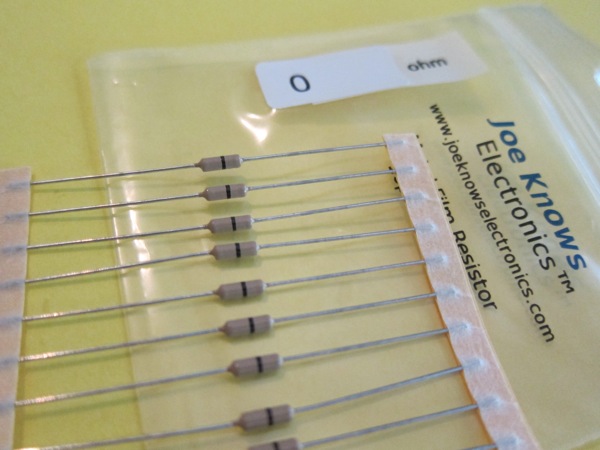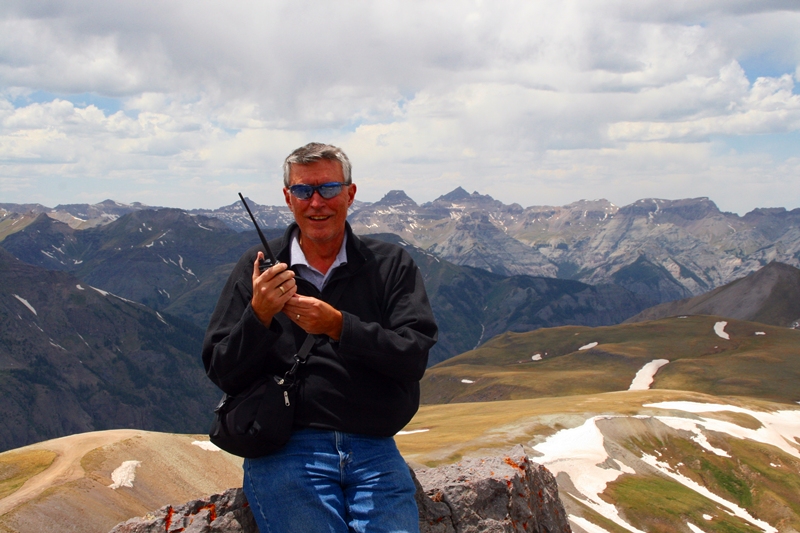Author Archive
 Introducing Ham Radio School
Introducing Ham Radio School
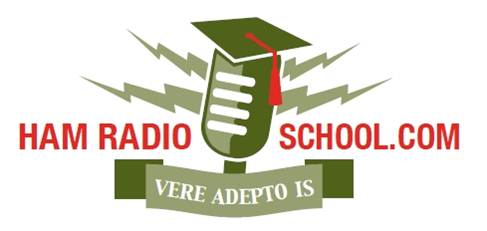 For several years now, I’ve been teaching a Technician License course with a team of instructors from our local radio club. We use a very successful 2-day format (90% success rate on the FCC exam), holding the class on 2 consecutive Saturdays at the local fire station. Our next session starts on Sept 29th.
For several years now, I’ve been teaching a Technician License course with a team of instructors from our local radio club. We use a very successful 2-day format (90% success rate on the FCC exam), holding the class on 2 consecutive Saturdays at the local fire station. Our next session starts on Sept 29th.
For this compressed two-day class, we’ve been using the Gordon West Technician Class book and (optionally) encouraged the class to read the ARRL Ham Radio License Manual. The Gordon West book is very focused on the exam questions, with some explanation around each one. The ARRL book is more thorough and deeper technically, so it is a good reference to round out the student’s understanding. Basically, the Gordon West book is good for “teaching the exam questions” and the ARRL book is good for providing a more comprehensive understanding.
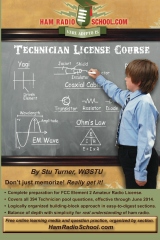 My fellow instructor, Stu Turner WØSTU, got the idea into his head that it would be good to create a license manual that gave a solid treatment of the material while still highlighting the specific questions on the exam. The next thing you know, he is off creating a new book, Ham Radio School.com Technician License Course. Stu did an excellent job writing this book, keeping it focused on the relevant topics but going beyond just teaching the exam questions. He also has a good knack for keeping it interesting.
My fellow instructor, Stu Turner WØSTU, got the idea into his head that it would be good to create a license manual that gave a solid treatment of the material while still highlighting the specific questions on the exam. The next thing you know, he is off creating a new book, Ham Radio School.com Technician License Course. Stu did an excellent job writing this book, keeping it focused on the relevant topics but going beyond just teaching the exam questions. He also has a good knack for keeping it interesting.
The story didn’t end there. One thing led to another and the book concept blossomed into a integrated learning system that includes a web site, iPhone/iPad app and (of course) the book. The web site offers some written content and interesting videos that help people learn about amateur radio. I will be contributing some material to the web site from time to time.
The Ham Radio School iPhone app is really sweet…check it out on iTunes. All the questions from the current Technician question pool are included in both review-style quizzes and in properly weighted, full 35-question practice exams, just like the one you’ll take at your VE session.
The most important thing is that the book, the web site and the iPhone app are coordinated and work together as a system. We all have different learning styles, so the system approach allows the student to focus on what suits them best.
73, Bob K0NR
 Technician License Class – Sept 2012
Technician License Class – Sept 2012
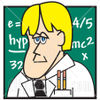 Monument, Colorado
Monument, Colorado
Saturday Sept 29 and Saturday Oct 6 (8 AM to 5 PM) 2012
Location: Tri-Lakes Monument Fire Station 1
Sponsored by the Tri-Lakes Monument Fire Radio Association
The Technician license is your gateway to the world-wide excitement of Amateur Radio…
- Earn your ham radio Technician class radio privileges
- Pass your FCC amateur radio license exam right in class on the second day
- Multiple-choice exam, No Morse Code Required
- Live equipment demonstrations
- Learn to operate on the ham bands, 10 Meters and higher
- Learn to use the many VHF/UHF FM repeaters in Colorado
- Find out how to participate in emergency communications
There is no cost for the class (donations accepted)
However, students must have the required study guide:
HamRadioSchool.com Technician License Course $19.95
And pay the FCC Exam Fee: $15.00
Advance registration is required (no later than one week before the first session, earlier is better!)
To register for the class, contact: Bob Witte KØNR
Email: bob@k0nr.com or Phone: 719 659-3727
For more information on amateur (ham) radio visit www.arrl.org or www.wedothat-radio.org
 Waldo Canyon Wildfire in Colorado
Waldo Canyon Wildfire in Colorado
You probably already heard about the terrible wildfire on the west side of Colorado Springs. The fire burned 18,247 acres, destroyed 346 homes and killed 2 people.
Here’s a map of how the fire progressed over time.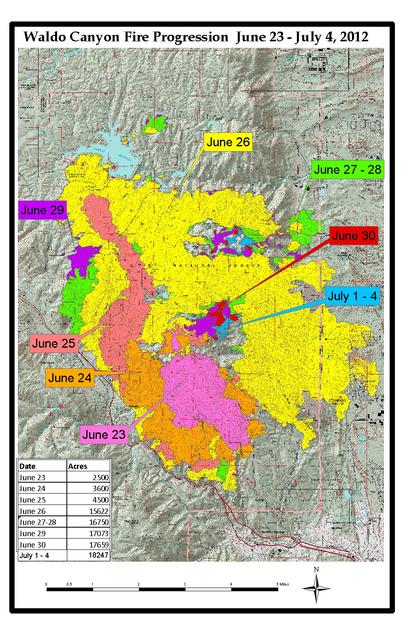
18,247 acres is a little more than 28 square miles of area burned. Think about a fire that consumes 28 square miles in your back yard. Pretty sobering.
Here’s a time lapse video that shows the fire from a distance.
The Denver Post has some of the best photos of the fire as it burned structures on the northwest side of Colorado Springs.
There were two major ham radio activities (that I am aware of) in response to the fire:
The RACES team (Special Communications Unit) attached to the El Paso County Sheriff’s office staffed the Emergency Operations Center in Colorado Springs. I did help out for one 12-hour shift, a relatively minor role.
Pikes Peak ARES supported the Red Cross, who operated the emergency shelters for ~32,000 people that had to evacuate their homes. The Pueblo newspaper ran an article about this.
The real heroes are the firefighters that battled the blaze, especially on that terrible Tuesday night when so many houses were lost. Those guys and gals are awesome!
- 73, Bob K0NR
 Colorado 14er Event – Now With SOTA!
Colorado 14er Event – Now With SOTA!
 Amateur Radio operators from around Colorado will be climbing many of Colorado’s 14,000-foot mountains to set up amateur radio stations in an effort to communicate with other radio amateurs across the state and around the world. The prime operating hours on August 5th are from approximately 9 AM to noon local time (1500 to 1800 UTC), but activity may occur at other times during the day.
Amateur Radio operators from around Colorado will be climbing many of Colorado’s 14,000-foot mountains to set up amateur radio stations in an effort to communicate with other radio amateurs across the state and around the world. The prime operating hours on August 5th are from approximately 9 AM to noon local time (1500 to 1800 UTC), but activity may occur at other times during the day.
New this year: Summits On the Air (SOTA) activity, which adds 1700 additional potential summits! If you aren’t up to climbing a 14er, there are many other summits to choose from (with a wide range of difficulty). See the W0 SOTA web page for details.
Radio operators that plan to activate a summit should register their name and intended peak at the ham14er Yahoo! group. To subscribe to the event mailing list, visit the yahoo groups site at . Also, be sure to check out the event information at 14er.org
Frequencies used during the event
Activity can occur on any amateur band including HF and VHF. The 2M FM band plan uses a “calling frequency and move up” approach. The 2M FM calling frequency is 147.42 MHz. At the beginning of the event, operators should try calling on 147.42 MHz. As activity increases on that frequency, operators should move up the frequency using the standard channel spacing used in Colorado (15 kHz). Don’t just hang out on 147.42 MHz…move up! The next standard simplex frequency up from 147.42 MHz is 147.435 MHz, followed by 147.45, 147.465, 147.480, 147.495, 147.51, 147.525, 147.54, 147.555, 147.57 MHz.
Don’t just hang out on 147.42 MHz…move up and share the band.
| Frequency (MHz) | Comments |
| 147.42 | Primary 2M FM Frequency, then up in 15 kHz steps |
| 223.5 | Primary 222 MHz FM frequency |
| 446.000 | Primary 70 cm FM frequency |
| 446.025 | Alternate 70 cm FM frequency |
| 52.525 | Primary 6M FM frequency |
| 1294.5 | Primary 1.2 GHz FM frequency |
| 144.200 | 2M SSB calling frequency |
| 50.125 | 6M SSB calling frequency |
| 14.060 | 20M CW Frequency |
| 21.060 | 15M CW Frequency |
| 28.060 | 10M CW Frequency |
| 14.260 | 20M SSB Frequency |
| 18.1575 | 17M SSB Frequency |
| 21.330 | 15M SSB Frequency |
| 28.350 | 10M SSB Frequency |
| Other Bands/Modes | Standard calling frequencies and/or band plans apply. |
Warning: Climbing mountains is inherently a dangerous activity.
Do not attempt this without proper training, equipment and preparation.
Sponsored by The Colorado 14er Event Task Force
 Zero Ohm Resistors
Zero Ohm Resistors
Mark Frauenfelder innocently (or cleverly) asks the question “What are zero ohm resistors for?” on BoingBoing. The fun really starts in the comments section, with replies such as “They’re a novelty gift for electronic engineers.”
Take a look at the article here.
Yes, zero ohm resistors really do exist. Think of them as jumpers on a PC board.
73, Bob K0NR
 2012 Field Day: K0NR Results
2012 Field Day: K0NR Results
 For 2012 ARRL Field Day, we operated from the cabin in portable style. Temporary wire antennas were tossed into the trees and the trusty Honda EU1000 generator provided emergency power. The Spousal Unit, Joyce KØJJW got on the air and made some contacts, making this a multi-op effort.
For 2012 ARRL Field Day, we operated from the cabin in portable style. Temporary wire antennas were tossed into the trees and the trusty Honda EU1000 generator provided emergency power. The Spousal Unit, Joyce KØJJW got on the air and made some contacts, making this a multi-op effort.
We used a similar approach as last year, see my post, ARRL Field Day: Season to Taste. The main difference is that the sporadic-e on 50 MHz wasn’t as good this year, but we had a fun time working the event.
Band Mode QSOs
7 SSB 15
14 USB 78
21 USB 73
50 USB 33
144 USB 3
420 FM 1
Total Both 203
Score: 406As usual for Field Day, most of the time the 20 Meter phone band was crammed with stations calling CQ Field Day. There were many times that I responded to one call and had another radio operator think I was working them. It occurs to me that we have this emphasis on exposing new people to ham radio during Field Day via the GOTA stations and public demonstrations. However, this is kind of like showing someone the joy of driving a car by having them experience a giant traffic jam. Is this really the best way to introduce people to ham radio?
Field Day: Make it your own!
73, Bob K0NR
 How Not to Do a SOTA Activation
How Not to Do a SOTA Activation
This weekend my wife and I were out exploring the San Juan Mountains near Ouray, Colorado. We found ourselves on a Jeep road to Engineer Pass. When we got to the pass, we stopped to have lunch and I examined the high peaks nearby. I saw some people on the summit of one of the peaks, which I determined was Engineer Mountain by looking at a topo map.
Hmmm, I said to myself, Engineer Mountain is a valid peak (W0/SJ-011, 12968 feet elevation) for a Summits On the Air (SOTA) activation. The only portable radio I had with me was a Yaesu VX-8GR with the stock rubber duck antenna. Not a great SOTA station. But if I could whistle up 4 contacts on 2M FM simplex, I would have a legitimate activation. We had already decided to climb to the summit, so any radio activity was just icing on the cake.
So off we went up the mountain. I got to the top and started calling on 146.52 MHz FM. Now it hits me that we are in the middle of a national forest, away from population centers and, to top it off, no one is expecting a SOTA activation here today. This might be a bit of a challenge to make 4 contacts. Then Thomas, KRØNK, answered my CQ. OK, there’s one contact. A little bit later Dave, AKØMR, comes on frequency and gives me a second contact. Both of these guys were in Grand Junction, CO, which is about 100 miles from Engineer Mountain. Not bad for a peanut-whistle HT using a standard rubber duck antenna.
I needed two more contacts. I tuned around for a repeater in the area and came across the 147.27 MHz machine which turned out to be a stones throw away from my location. It requires a CTCSS tone, so I fumbled around until I figured that out. No, I did not have a repeater directory with me…that was safely stored in the Jeep at the bottom of the mountain. I gave a quick call with my location and Ben WB5ITS came back to me. We QSY’d over to 146.52 to make my third contact. Anticipating a rough go of it, I asked my wife Joyce K0JJW to descend off the peak while I remained at the top, so she could be my fourth contact. (SOTA rules do not allow contacts between parties on the same peak.)
Somewhere along the way, I reach for a piece of paper to log the contacts, only to find that I did not have a writing utensil with me. Duh. I would have to remember the times and callsigns of the contacts and write them down later.
I completed the fourth contact and headed down. Later that evening I checked the ListsofJohn database and found that there are actually two peaks in the area called Engineer Mountain. Go figure. The SOTA database only recognizes one of them…of course, you guessed it, not the one I was on. It turns out that the Engineer Mountain I was on is subordinated by an adjacent peak: Darley Mountain (W0/RG-034, 13260 feet). However, since I operated from 13,218 feet on my Engineer Mountain, it is within the 75 foot vertical activation zone for Darley Mountain. So, this does count for a SOTA activation of Darley Mountain.
This is where I could claim that incredible skill, flexibility and a little luck ruled the day. I think a more appropriate analysis is to concede that a complete lack of planning and preparedness produced a marginal result.
What can we learn from this?
- Do your homework concerning the SOTA peak that you intend to activate before you start the climb. Make sure you know where it is and that you are really on it.
- Always keep a notepad and pen/ pencil in your backpack
- Even for casual hikes, take along a decent antenna for the HT. A half-wave vertical is way better than a stock rubber duck.
- Plan in advance so you can post your intended SOTA activation on sotawatch.org
- Have a repeater directory (or equivalent) available to identify repeaters in the area.
- And don’t forgot the normal hiking Ten Essentials
Beyond doing a SOTA activation, some of these items could be important if an emergency should occur. It runs out there was no mobile phone coverage in the area. I used to be pretty vigilant about taking an HT with spare batteries and extended antenna along on hikes but have gotten sloppy lately. See Rescue on Uncompahgre Peak, which describes an incident years ago when my radio turned out to be very useful during an emergency.
In the end, I did complete my first SOTA activation, so I can be happy about that. And it gave me the opportunity to relearn a few things about planning and being prepared.
73, Bob KØNR
P.S. The WØ SOTA guys recently created a great W0 SOTA page.
